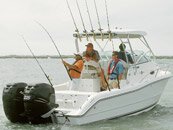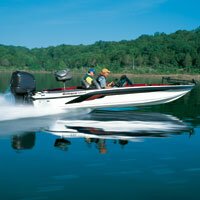Chinook Salmon
Oncorhynchus tshawytscha
AKA: King salmon, blackmouth
Distinguishing Markings:
Two dorsal fins including one adipose fin, inside the mouth and gums, black, small spots on upper back and tail, 15 - 17 rays in anal fin.
Size:
The largest of the Pacific salmon, averaging 30 to 40 pounds, occasionally growing to over 100 pounds,
Distribution:
Endemic to the Pacific and rarely, the Arctic Ocean. Introduced elsewhere but with little breeding success
Habitat:
Pacific salmon are anadramous, spending part of their life in fresh water and part in saltwater. Prefer cold water with a high oxygen content, Pacific Ocean, the Great Lakes.
Food Preference:
Baitfish, squid. Young chinook in rivers eat insects, insect larvae and crustaceans
Spawning:
Adult salmon return to their native streams to spawn and always die after completing their spawning runs
Fishing Tips:
The biggest saltwater kings are caught in summer and early fall when mature salmon move toward freshwater spawning grounds. In spring, fish the rivers of the Pacific Northwest. Trolling or mooching (drifting) with herring, jigging with any of several baitfish-imitating metal jigs, or trolling with plugs, spoons, plastic squid or other artificials. Fishing near the bottom is often the key to success.
See Also:
- 30 Secret Fishing Tips
- 27 Ways To Tell If You’re A Fishing Fanatic
- When To Fish
- Fighting A Fish
- Codes of Angling Ethics
- Fishing With Kids
- Where Do Fish Live?
- Discover Fishing
- Fishing Tips - Rod Storage
- Fly Fishing Boats
- What’cha Eating? Bait Matrix
- Ten Tips for Clean and Green Boating
- Fishing Accessories - Tips from the Boating Guy
- Boating is Affordable
- Saltwater Fishing Boats: Find a Fishing Boat at DiscoverBoating.com
- Saltwater Fishing Tips: Boating Information for Saltwater Fishing
- Sport Fishing Boats: Find A Fishing Boat
- Big Choices: The basics of big-game fishing equipment
- Saltwater Fishing Boats
- Selecting Your Saltwater Fishing Gear
- Selecting Fishing Tactics Overview

